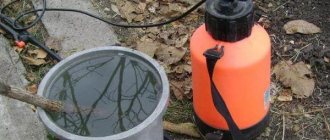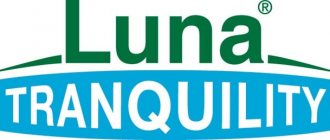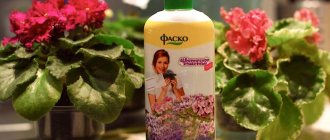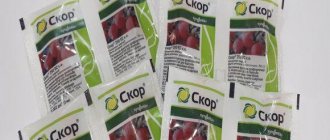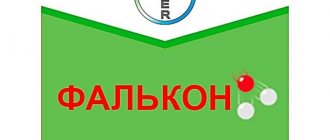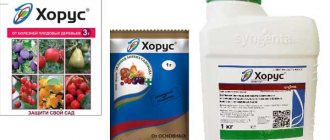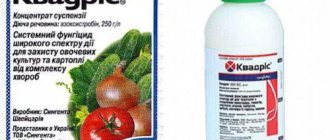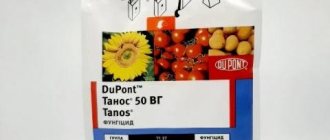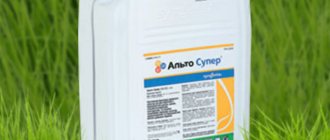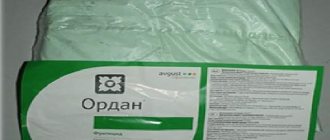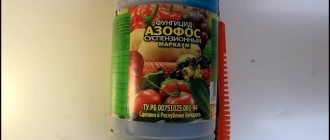Fungicide Strobi - instructions for use
Strobi comes in the form of granules that quickly dissolve in water. The solution is prepared immediately before use according to the standards. Its greatest effectiveness is observed in the first two hours after preparation. In this regard, it is necessary to use the solution within this time.
Work should be carried out in dry weather, preferably in the morning or evening. In order for the plant to be completely treated with the solution, it is recommended to spray on a windless day.
Strobi fungicide is classified in the third, moderately dangerous class. It does not pose a danger to humans, animals, or birds. Strobe is practically harmless to bees, but before you start treating plants, it is still necessary to notify local beekeepers in advance. The practice of using this Strobi fungicide shows that a border protection zone of a maximum of 2 km is sufficient for bees.
The number of fungicide treatments depends on the type of plant. To prevent flowers from powdery mildew and rust, spraying should be carried out during their growing season 2-3 times every 10 days. The exception is roses. They need to be treated twice a month, starting on July 1 and before sheltering for the winter. In this case, it is necessary to treat not only the foliage, but also the soil around the roses
Please note that when treating fungal diseases in flowers, the fungicide is only effective in combination with other drugs
Vegetable crops are treated with Strobi twice during their growing season. The solution destroys diseases such as late blight and powdery mildew in tomatoes, downy mildew in cucumbers, and brown spot, which affects carrots and peppers. It is recommended to alternate the Strobi fungicide solution with other drugs. The waiting time, which is the period from the date of the last treatment until the harvest, differs for vegetables growing in open ground and greenhouses. For cucumbers and tomatoes growing in open ground, this period is 10 days; for tomatoes growing in greenhouses - 5 days, and for cucumbers - 2 days.
Fruit trees are processed three times during the growing season with an interval of 14 days. The last spraying must be carried out 35 days before the start of fruit harvesting. The solution is prepared based on the growth of the tree. For 1 meter of plant, 2 g of the drug per 10 liters of water is enough. Alternating the drug with other similar ones is mandatory.
Fungicide Strobi effectively affects the destruction of scab, powdery mildew, root canker and other diseases of grapes. Treatment must be carried out throughout the entire growing season. In this case, you should spray not only the leaves, vines and fruits, but also the soil in the root zone. The solution is applied twice within 7-10 days. Treatment must be stopped one month before harvest.
Description of the drug
The product has shown its effectiveness in the treatment of many diseases caused by fungi. Manufactured in Germany. Available in bags, it looks like water-soluble granules of light brown color. Dissolves in water at 20 °C in an amount of 0.002 g/l. Refers to substances of the 3rd hazard class.
Compound
The chemical is part of the class of strobirulins. The active substance in Strobi is kresoxyl-methyl, which has a high level of bactericidal activity. Preparations containing this chemical substance have therapeutic and protective properties. Treatment is carried out only if there are obvious symptoms of the disease.
Mechanism of action
“Strobi” is an effective drug belonging to a new generation of pesticides that simultaneously treats several diseases of grapes and many other plants. Its action is to suppress the development of pathogenic microorganisms. The main advantage of its use is that it does not harm animals and people.
Area of influence
The pesticide acts systemically and locally, suppresses the cellular respiration of the fungus, leading to its death. It inhibits the spores that form and reduces the rate of spread of this disease.
Period of protective action
If fungal diseases cause minor damage to the grapes, the drug is effective for 2 weeks. In other severe cases - about 10 days.
To obtain maximum effect, it is necessary to correctly alternate chemical treatment agents.
Frequency of treatments
Standard instructions for using the Strobi fungicide for grapes involve treating the bushes 2 times. Between the first and second procedures there is a break of 7-10 days. The remedy is universal because it is used not only for prevention, but also for treatment.
Waiting time for grapes
It is appropriate to carry out treatment throughout the entire growing season. Both leaves and soil in the root zone, berries and vines are sprayed. The mixture is used twice within 7-10 days. Treatment is stopped a month before the start of berry picking.
How to use the drug "Strobi"
According to the instructions for use for grapes, the drug should be diluted in the following proportion: a teaspoon of granules (5 grams) per ten liters of water. The resulting solution is used to spray grapes throughout the growing season. It is necessary to treat not only the leaves, but also the branches and the ground near the roots. You need to use Strobi twice a week (or 10 days). Processing should be completed when there are about 30 days left before harvest.
To ensure that the use of Strobi for spraying is as effective as possible, follow the recommendations recommended by professionals:
- This product can be used with both pesticides (Fastak, BI-58) and fungicides (Poliram, Delan). If you decide to combine it with other drugs, then you must check their compatibility;
- To avoid the plant becoming accustomed to spraying with this product, it is necessary to periodically treat the bushes with drugs belonging to other groups;
- Do not use the drug near sources of drinking water;
- Spray in the morning or early evening.
In addition, it is important to know about safety precautions for working with this drug. If the solution gets on you when spraying, quickly take off your clothes and rinse your skin under running water.
If you accidentally inhale the drug, stay in the fresh air. If the Strobi solution gets into your eyes, rinse them thoroughly with water. If the drug is swallowed, drink as much water as possible and seek medical attention.
If you want the grapes on your plot to grow healthy and consistently produce high yields, use modern means for the prevention and treatment of various diseases.
"Strobi" is one of the best drugs in its class. It is he who effectively treats grapes infected with microbial and fungal diseases. If you follow the instructions for using the Strobi fungicide for treating grapes, you can quickly eliminate the source of infection. This pesticide does not allow the spores to develop further, stopping further development of the mycelium.
What is the purpose of the drug
The appearance on sale of a fungicide that is effective against severely damaged plants by pathogenic fungi and at the same time safe enough for use on ripening fruits caused a sensation at the time. Strobi has even been dubbed a new generation drug. True, the sensation did not completely materialize: the drug turned out to be quite difficult to use (see below) and causes resistance in the affected objects. However, the trail remains undeniable. its advantages:
- The use of Strobi makes it possible to reduce the dose of toxic pesticides per unit of land area by at least 1.5-2 times.
- The final treatment of the season with this preparation can be carried out at almost any stage of crop ripening, which sharply reduces its losses during storage.
- A wide spectrum of action does not require accurate diagnosis of the disease and, accordingly, deep knowledge of agricultural technology by the user.
- The drug is most effective when applied to wet foliage. In the temperature range of +(1-4) degrees Celsius, Strobe activity increases from initial to almost complete. That is, Strobi is most effective as a spring preventive fungicide for a garden or vineyard. Spring prevention with a safe product allows you to further reduce the consumption of toxic chemicals.
As a result, firstly, the drug Strobi has proven itself to be excellent in conditions of closely spaced plantings in small areas: fruits from adjacent plots of land to the treated area can be consumed without fear. Therefore, Strobi is already very popular in dachas and garden plots, see for example. video:
Video: Strobes for plant and fruit protection
Secondly, when the above-ground fruits of plants are intended for long-term storage. Tubers and tuber crops are much easier to protect from the accumulation of pesticide residues than pome fruits, stone fruits and berries. Therefore, Strobi was fully appreciated by gardeners, see the story:
Video: Strobes for spring garden processing
Fungicide Strobi stops the development of the mycelium of imperfect fungi and the sporulation phase; This drug only stops the growth of mycelial filaments. In fungi whose life cycle includes a stage of dispersal zoospores, Strobi deprives the latter of their motility. Since the life cycles of pathogenic and beneficial soil lower fungi are very different, Strobi has virtually no effect on soil-forming fungi when used correctly. Action Strobi preim. contact: the dried working solution forms a dense film on the plants that is not washed off by rain; The drug penetrates into plant tissues weakly, only while the working solution dries.
Instructions for use Strobi
The number of treatments with Strobi solution primarily depends on what type of crop is sprayed. According to the instructions for using the fungicide, fruit trees are sprayed no more than 3 times during the season, flower crops - 2-3 times - depending on the degree of infection. More frequent use of Strobi may lead to resistance. To avoid this, it is recommended that before each spraying with Strobi solution, treat with fungicides that do not belong to the stribilurin chemical class.
The working solution is prepared at the rate of 2 g of fungicide per 10 liters of water for vegetables (tomatoes, cucumbers, peppers), fruit trees; 2 g of Strobi per 6 liters of water - for grapes, 5 g of the drug per 10 liters of water for flower crops.
The most favorable time for spraying is morning or evening hours. To avoid spraying of the working substance onto neighboring plants, the treatment must be carried out in calm weather. Any procedures can be carried out with treated plants only 3 days after spraying. The last treatment of vegetable crops with Strobi solution should be carried out at least 5-10 days before harvesting, grapes - 1 month before removing the bunches, fruit trees - 35 days.
Precautionary measures
The drug should be stored in a specially designated place.
The fungicide has a detrimental effect on fish and can rapidly infect water bodies, so application near lakes and rivers should be carried out with great caution - do not spray during windy weather. If there is a beekeeping farm nearby, spraying must also be carried out in compliance with safety rules, since insects may die if exposed to the fungicide
It is recommended to protect the apiary from contact with the product - transport it to another place or close the exits from the hives
If there is a beekeeping farm nearby, spraying must also be carried out in compliance with safety rules, since insects may die if exposed to the fungicide. It is recommended to protect the apiary from contact with the product - transport it to another place or close the exits from the hives.
Period of protective action
In case of minor damage by fungal diseases, the fungicide is effective for 14 days, in difficult situations - 10 days.
To ensure a long-term protective effect, Strobi manufacturers recommend no more than 3 treatments per year. The optimal action of the fungicide is achieved through the correct alternation of products that protect crops from diseases and pests. Strobi fungicide is a universal chemical substance, using which you can significantly reduce the risk of plants being damaged by fungal diseases. The crops you grow will remain healthy, and at the end of the season you will receive a large and high-quality harvest. The main thing is not to neglect preventive treatments in order to cure the plant at the initial stage of damage.
Before you start using the drug, you should read reviews about it.
Every year I use Strobi to spray the apple trees in the garden. I like that the drug has an affordable price and gives excellent results. After the first spraying, positive changes are observed: the foliage acquires a bright shade, the fruits do not fall off. The main thing is not to carry out more than 3 treatments per season.
Thanks to the fungicide Strobi, I was able to save my vineyard. In the spring I treated the vine, and in the fall even the harvest increased. In addition, Strobi does not have such an aggressive effect on plants as classical fungicides. In some cases, even one spray is enough. You just need to follow the instructions.
I was able to quickly get rid of powdery mildew in my garden. I sprayed phloxes and roses with Strobi. Three treatments were enough: in July, August and September. Dissolve the fungicide on the tip of a spoon in 10 liters of water. From personal experience I can say that Strobi acts much faster than other advertised fungicides.
How does it work
“Strobe” evenly penetrates the structure of the leaf plates, distributed outside and inside, even when sprayed from one side. It suppresses the action of fungal pathogens and prevents the proliferation of secondary spores.
The dried substance creates a dense, indelible film on plants and penetrates poorly into tissues. The action of the fungicide appears after 2 hours for minor damage and after 2 days for severe disease. Retains protection for average infection for up to 14 days, for severe infection for up to 10 days.
Fungicide Strobi description
The contact action drug is produced in the form of water-dispersible small brown granules, which are diluted with water. The main active ingredient that is part of the fungicide is kresoxim-methyl.
News Media2
The active substance, falling on the leaves, is evenly distributed throughout all parts of the plant, suppressing the growth of fungal cells in them and the appearance of secondary spore formation. The fungicide is safe for the environment, animals and pollinating insects. The drug does not accumulate in fruits and is considered a biological means of combating plant diseases.
The solution forms a film on the surface of plants that is resistant to moisture. The fungicide is also resistant to atmospheric conditions and temperature changes. Having spread to various types of fungi, it does not require diagnosis of a specific disease.
Strobi is little absorbed into the soil, does not affect the composition of the soil, and after watering it decomposes into acids that do not pose a danger. Suitable for treating plants before winter and early spring, starting from above-zero temperatures.
On this topic:
BACK
FORWARD
1 of 46
The fungicide is well tolerated by crops and is compatible with other insecticides and fungicides, which is convenient for the use of complex plant treatment. Can be used both in open areas and in greenhouses.
Due to the low danger to living organisms and the ability of fungi to mutate, it is recommended to alternate fungicides and use drugs with different modes of action together. Analogs of the drug Strobi with a similar substance and principle of action are Boxwood, Strobitek. Instead of Strobi, Trichodermin and Prestige are used.
Strobes are used in tank mixtures with other drugs for a complex effect not only on diseases, but also with the use of insecticides on insect pests. Compatible fungicides: Delan, Cumulus, Quadris, insecticides: Bi-58, Fastak.
Release form and analogues
The original drug from BASF is produced in the form of granules, easily soluble in water. This chemical form is called water-dispersible granules - VDG.
The minimum packaging volume is 2 g, the maximum is 20 g.
The licensed release of Strobi in other countries is protected by the developer's trademark.
The only analogue of Strobi is the fungicide Boxwood. It contains the same active ingredient - kresoxim-methyl, as the original drug, but differs in the presence of difenoconazole.
“Boxwood” is not washed away by rain or watering. Combines well with many pesticides in tank mixtures, with the exception of alkaline substances.
Instructions for use of Strobi fungicide for tomatoes
Treat plants in calm, dry weather using a sprayer, evenly covering the plants with the working solution. Use the working solution on the day of preparation in the same way as the Coragen insecticide.
Application of Strobi fungicide for tomatoes
| Culture | Application rate of the drug | Harmful object | Method, processing time, application features | Waiting period (number of treatments) |
| Open ground tomato | 0,2-0,3 | Powdery mildew, late blight | Working fluid consumption is 400 l/ha. | 10(2) |
| Protected soil tomato | 0,2-0,3 | Powdery mildew, late blight | Working fluid consumption is 800-1000 l/ha. | 5(2) |
Recommendations for the use of Strobi fungicide
Compatibility with other pesticides: compatible with insecticides (BI-58 Novy, Fastak), fungicides (Delan, Poliram, Cumulus DF).
When applied together with other pesticides, a compatibility test should be performed before application.
Period of protective action: 10-14 days with average damage by fungal diseases, with high damage - 7-10 days.
Speed of effect: depending on the disease, the effect appears from 2 hours to 2 days.
Phytotoxicity: not phytotoxic.
Possibility of resistance: to ensure a long-lasting protective effect of the STROBI fungicide, BASF recommends no more than 3 applications per year. Optimal action is achieved by alternating the fungicide in the overall scheme of protective measures. Before and after using STROBI, it is recommended to use drugs from other groups that do not belong to strobilurin derivatives, for example Delan Poliram DF, Cumulus DF and Saprol. In general, you should not carry out more than 3 treatments per year with drugs from the strobilurin group.
Recommendations for the protection of useful objects of flora and fauna: the drug is low-toxic for warm-blooded animals and birds, practically not dangerous for bees (limit the flight of bees to 6-12 hours, treatments are recommended to be carried out in the morning and evening hours, with windiness up to 5-6 m/s, borderline -protection zone for bees - at least 1-2 km). In all cases, the use of pesticides requires compliance with the basic provisions of the “Instructions for the prevention of bee poisoning by pesticides” (Moscow, State Aviation Administration of the USSR 1989); in particular, it is necessary to provide preliminary (4-5 days) notification to local public and individual beekeepers (by press, radio) about the nature of the plant protection products planned for use, the timing and areas of its application. The use of the drug is limited in the sanitary zone around fishery reservoirs at a distance of 500 m from the flood line at maximum flood waters, but not closer than 2 km from the existing banks. Avoid polluting water bodies and sources of drinking water with the working solution, its residues and water used for washing sprayers, containers and other equipment.
Hazard class: - III (moderately hazardous compound).
First aid for poisoning:
- remove contaminated clothing;
- In case of contact with skin: wash thoroughly with soap and water;
- if inhaled: calm the victim, remove to fresh air;
- In case of contact with eyes: rinse eyes with open eyelids with running water;
- if swallowed: rinse mouth, drink as much water as possible, call a doctor;
- Instructions for the doctor: treatment according to symptoms (maintenance of vital functions) specific antidote is not known.
We recommend reading our other articles
- Grain crusher Khryusha 350
- Mobile grain dryers
- Fungicide Brunka
- Combine harvester New Holland CR 9080
Dosage and rules of use
As a rule, a sachet of the drug weighing 2 g is enough for one application for various crops. The ratio of water and fungicide in each specific case must correspond to the instructions. To achieve maximum effect, you should adhere to the following processing rules:
It is better to spray Strobi at a certain time - in the morning or evening, in calm weather; It is important to follow the recommended precautions when working; caring for the garden after using Strobi should be stopped for 3 days; you need to treat the stems, leaves, fruits and root zone of plants; for best effectiveness, before using Strobi, it is useful to pre-treat the crops with a fungicide of a different action according to the instructions on the package; spraying should be carried out no later than 7 days after the end of the rainy period, when the risk of pathogen development is highest.
Important! Late blight, powdery mildew and other fungal infections develop rapidly in a humid environment in rainy weather
For grapes
In terms of effectiveness and safety, Strobi is considered one of the best fungicides for vineyards, helping to suppress the growth of mycelium and treat vines already affected by fungi. It protects the crop from other types of pathogens.
Instructions for use for grapes:
- One sachet of Strobi (2 g) is dissolved in 6 liters of water.
- Spray 2 times per season.
- The last treatment is carried out at least 28 days before harvesting.
For trees
Fruit trees are most susceptible to scab and powdery mildew. When using Strobi, the processes of germination of fungal spores are significantly slowed down, and the development of other damage, for example, rot, stops. For maximum effectiveness, it is recommended to alternate or mix Strobi with other fungicides, for example, Horus, Ridomil.
Instructions for use for fruit trees:
- A packet of powder is dissolved in 1 bucket of water.
- Spray no more than 3 times per season.
- Stop processing 3 weeks before harvesting the fruits.
Important! The effect of the drug is especially noticeable on apple and pear trees, the foliage of which, after treatment, becomes rich green, healthy and shiny.
For flowers
Powdery mildew and rust are destructive to many types of flower crops. To prevent plants from becoming accustomed to the frequent use of Strobi, the instructions recommend combining the fungicide with similar agents or alternating it with drugs of a different mechanism of action. Strobi is used for flowers only one year, the next year the treatment is excluded.
Instructions for use for flowers:
- 2 g of powder are diluted in 5 liters of water.
- Spray every 10 days.
Instructions for using Strobi for garden roses are as follows:
- Treatment is carried out every 2 weeks, the last time before sheltering for the winter.
- Spray the rose bushes carefully, always including the near-standard circle in the treatment area.
For vegetables
A fungicide for vegetable crops is used for various infections. Tomatoes most often suffer from late blight, cucumbers are susceptible to powdery mildew, and downy mildew is observed in onions and garlic. Spraying of vegetables is carried out not only when infected, but also to prevent the above diseases.
Instructions for use for vegetables:
- A sachet of the drug is dissolved in 10 liters of water;
- Treat with an interval of 10 days in open ground and 7 - 8 days in closed ground.
- Spraying is stopped no later than 12 days before harvest.
For maximum effectiveness, it is recommended to alternate Strobi with other fungicides. It will not be used the following year. For preventive purposes, it is necessary to observe crop rotation, correctly changing the planting location.
Advantages of the drug
In the fight against fungal diseases, a huge number of pesticides have been synthesized - Quadris, Ridomil Gold, Chorus. They have properties similar to the strobe fungicide, but are inferior in many respects:
- Low toxicity and safety for bees, animals and humans. This property allows processing to be carried out in any period of the growing season, including during the flowering of grapes.
- Possibility of spraying on wet leaves and grass. Resistance to precipitation.
- Versatility. The drug destroys mycelium, disinfects the soil, and treats affected plants from most fungal diseases.
- High profitability. The drug has a good ratio of effectiveness and price.
- Independence from ambient temperature. You can start work at a temperature of +1°C.
Compatibility with other drugs
To save processing time, gardeners often use tank mixtures. They include fungicides, insecticides, growth stimulants and fertilizers. The drug strobi is compatible with almost all of the listed components.
Strobi combines well with the fungicides quadris, ridomil gold, topaz, etc. It is also used with insecticides. Instructions for use of a mixture of the drug strobi for grapes:
- 2 g of strobe fungicide is dissolved in 3 liters of water at a temperature of 20-22 °C;
- Separately, an ampoule of Neoron insecticide (125 ml) is stirred in the same volume of liquid.
- stimulants Epin or Zircon (1 ml) are added to 2 liters of water;
- all three components are combined, and the volume is brought to 10 liters of water.
Additional Information! Strobi is resistant to being washed off by rain, which cannot be said about other preparations, so an adhesive or soap solution can be added to the mixture.
This mixture as a whole will increase the effectiveness of protecting the vineyard from diseases and pests, and will also help accelerate growth, increase immunity and productivity.
But you should always remember that not all components are compatible, and they must be entered in strict sequence:
- first of all, you need to dilute the powder preparations, they dissolve in water and are introduced into the solution;
- the second are liquid pesticides or components in the form of an emulsion;
- the final ones will be growth stimulants or fertilizers.
Important! It is always necessary to maintain the proportions of the drugs, their violation can lead to even greater harm to the plant
Invalid connections
Incorrect composition of drugs can lead to stratification of the mixture and loss of therapeutic functions. Strobi fungicide cannot be used in the following compounds:
- copper-containing preparations (including copper sulfate, Bordeaux mixture);
- fertilizers containing copper, zinc and iron.
The modern fungicide strobi opens up new prospects in the fight against harmful fungi. Thanks to its mechanism of action and safety, it is among the top most popular drugs for the treatment and prevention of grape diseases.
Advantages and disadvantages
The use of the agrochemical is allowed during the flowering period; it is effective even if it partially gets on the leaves. It is also allowed to process wet sheet plates at temperatures from +5 C. Protection is effective for up to 1.5 months. The product is economical and has low toxicity.
See also
Instructions for use of the herbicide Boxer, mechanism of action and consumption ratesRead
The disadvantages are that mushrooms can change and become resistant to the action of the fungicide.
Advantages and disadvantages
Fungicide Ridomil Gold is an effective product that has many advantages over analogues:
- the effect of the treatment is rapid, even with diseases in an advanced stage;
- the components of the drug completely destroy fungal spores, which contributes to the complete elimination of the lesion;
- does not cause resistance;
- the effect of the product is noticeable in those parts where there was no treatment;
- when diluting the solution, exact dosage is not required;
- the effect of the product does not depend on cultivation conditions, processing is carried out according to standard regulations and established schemes;
- when using, no additional safety measures are required other than traditional ones (storage out of reach of children and animals);
- perfectly stored at different temperatures: from -10 to +35 degrees;
- The strength of the components in unopened packaging is not lost throughout the entire shelf life.
This chemical has a number of significant disadvantages:
- Toxicity (hazard class 2 for humans and class 3 for bees);
- Limited spectrum of action, the diseases it treats cause significant growth restriction and yield loss in plants;
- The cost of the drug is high compared to other fungicides that are sold retail in stores today;
- The product must not be stored open; it should be used immediately in full;
- When fungi are destroyed on a plant, beneficial microorganisms in the soil are removed, therefore, with frequent use of Ridomil, the composition of the soil can greatly deteriorate;
- In those areas where treatment with Ridomil solutions is carried out, the addition of compost and humus is simply useless;
- The fungicide can accumulate in plants, which gives long-term negative consequences;
- The phytotoxicity of the drug is weak if all the rules for diluting the solution are observed, but if there is an excess of the drug, the toxicity increases sharply.
Recommendations for preparing and storing the working solution
Features of preparing the working solution
- The contents of the package are dissolved in one liter of water until a homogeneous liquid without crystals is obtained.
- The main container is filled halfway with water and the concentrated solution is poured into it with continuous stirring.
- Finally, the mixture is topped up with water to the specified level.
Period of use and storage
Hermetically sealed, undamaged packaging can be protected for 5 years from the date of production.
The prepared solution cannot be stored; it must be used within two to three hours.
Reader Questions
What is the price of Strobi fungicide?
The cost of the drug varies depending on the manufacturer. The average price of Strobi is 100 rubles per 2 grams. Foreign manufacturers price their goods at 2000 rubles per 200 grams. And at first glance, this may seem overpriced. Considering that only 2 grams are needed to process 100 bushes, Strobi is quite a profitable purchase.
Does Strobi help against late blight?
Yes, Strobi is one of those drugs that perfectly eliminates late blight, including in conditions of high humidity.
What diseases does Strobi fungicide help with?
Fungicide Strobi copes with many diseases:
- spotting (dry, white, brown, black, ring);
- late blight;
- leaf spot;
- rot;
- rust;
- scab;
- mildew;
- anthracnose;
- gray mold and others.
What is the hazard class of Strobi?
Strobi hazard class is 3 for both humans and bees.
For more than two decades, synthetic biological preparations based on natural toxins have been successfully used in agriculture. One of them is the fungicide Strobi. The instructions for use characterize it as a universal remedy in the fight against fungal microflora.
The active substance of the drug is based on strobilurins - derivatives of betamethoxyacrylic acid, isolated from a family of common mushrooms. The mechanism of their action is to suppress mitochondrial respiration of pathogen cells by blocking ATP synthesis and is most intense in the early stages of infection, preventing mycelial growth and further sporulation.
Area of effect of the fungicide
The drug Strobi is intended to effectively combat the following plant diseases:
- Scab.
Tinder fungus.- Spotting of all types.
- Stem rot and late blight.
- Rubella.
- Gray mold.
- Mildew.
- Stemphiliasis.
- All types of rust.
- Powdery mildew.
- Black.
